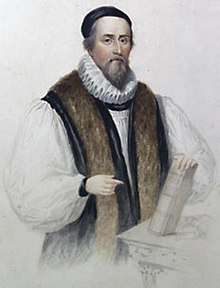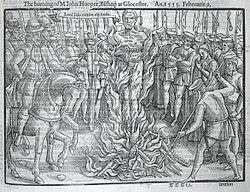John Hooper (bishop)
John Hooper (also Johan Hoper; c. 1495 – 9 February 1555) was an English churchman, Anglican Bishop of Gloucester, and Worcester, a Protestant reformer and a Protestant martyr. A proponent of the English Reformation, he was executed for heresy by burning during the reign of Queen Mary I.
The Right Reverend John Hooper | |
|---|---|
| Bishop of Gloucester Bishop of Worcester | |
 | |
| Church | Church of England |
| Diocese | Gloucester Worcester |
| In office | 1550-1554 (Gloucester) 1552-1554 (Worcester) |
| Predecessor | John Wakeman (Gloucester) Nicholas Heath (Worcester) |
| Successor | James Brooks (Gloucester) Nicholas Heath (Worcester) |
| Orders | |
| Consecration | 8 March 1551 by Thomas Cranmer |
| Personal details | |
| Died | 9 February 1555 Gloucester, Gloucestershire, England |
| Nationality | English |
| Denomination | Anglican |
| Spouse | Anne de Tscerlas |
| Children | 2 |
| Alma mater | Merton College, Oxford |
Early life
In 1538, a John Hooper appears among the names of the Black Friars at Gloucester, and also among the White Friars at Bristol, who surrendered their houses to the king. A John Hooper was likewise canon of Wormesley Priory in Herefordshire; but identification of any of these with the future bishop is doubtful. Rather, he appears to have been in 1538 rector of Liddington, Wiltshire, a benefice in Sir Thomas Arundell's gift, though he must have been a non-resident incumbent. The Greyfriars' Chronicle says that Hooper was "sometime a white monk"; and in the sentence pronounced against him by Stephen Gardiner he is described as "olim monachus de Cliva Ordinis Cisterciensis," i.e. of the Cistercian house of Cleeve Abbey in Somerset. On the other hand, he was not accused, like other married bishops who had been monks or friars, of infidelity to the vow of chastity; and his own letters to Heinrich Bullinger are curiously reticent on this part of his history. He speaks of himself as being the only son and heir of his father and fearing to be deprived of his inheritance, if he adopted the reformed religion.
Prior to 1546, Hooper had secured employment as steward in Arundell's household. Hooper speaks of himself during this period as being "a courtier and living too much of a court life in the palace of our king." But, he chanced upon some of Huldrych Zwingli's works and Bullinger's commentaries on St Paul's epistles, which elicited an evangelical conversion. After some correspondence with Bullinger on the lawfulness of complying, against his conscience, with the established religion, and following some trouble in England c. 1539–40, with Stephen Gardiner, bishop of Winchester to whom Arundell had referred him out of concern for his new views, Hooper determined to secure what property he could and take refuge on the continent. In Paris for an unknown period of time, Hooper returned to England to serve Sir John St Loe, constable of Thornbury Castle, Gloucestershire, Arundell's nephew.
Life on the continent
Hooper found it necessary to leave for the continent again, probably in 1544, and he reached Strasbourg by 1546. He decided to permanently move to Zürich. But first, he returned to England to receive his inheritance, and he claims to have been twice imprisoned. In Strasbourg again, in early 1547, he married Anne de Tserclaes (or Tscerlas), a Fleming who with her sister had lived in the household of Jacques de Bourgogne, seigneur de Falais.[1] He proceeded by way of Basel to Zürich, where his Zwinglian convictions were confirmed by constant intercourse with Zwingli's successor, Heinrich Bullinger. He also made connections with Martin Bucer, Theodore Bibliander, Simon Grinaeus, and Konrad Pellikan. During this time Hooper published An Answer to my Lord of Wynchesters Booke Intytlyd a Detection of the Devyls Sophistry (1547), A Declaration of Christ and his Office (1547), and A Declaration of the Ten Holy Commandments (1548).
Chaplain at the centre of power
It was not until May 1549 that Hooper returned to England. There, he became the principal champion of Swiss Calvinism, against the Lutherans as well as the Catholics, and was appointed chaplain to Edward Seymour, 1st Duke of Somerset, the Lord Protector. Hooper had a hand in the formation of the Zwinglian-inspired Dutch and French Stranger churches in Glastonbury and London. Hooper enjoyed at this time a friendship with Jan Łaski, and served as a witness for the prosecution in Bishop Bonner's trial in 1549.
Somerset's fall from power endangered Hooper's position, especially as he had taken a prominent part against Gardiner and Bonner, whose restoration to their sees was now anticipated. However, John Dudley, Earl of Warwick (subsequently Duke of Northumberland), who now dominated the council, continued Somerset's Protestant religious policies. Hooper now became Dudley's chaplain.
Vestments controversy
After a course of Lenten sermons before the king, he was offered the bishopric of Gloucester. This led to the prolonged vestments controversy; in his sermons before the king and elsewhere Hooper had denounced the "Aaronic vestments" and the oath by the saints, prescribed in the new Ordinal; and he refused to be consecrated according to its rites. Thomas Cranmer, Nicholas Ridley, Martin Bucer and others urged him to submit. Confinement to his house by order of the Council proved equally ineffectual, and it was not until he had spent some weeks in the Fleet prison that the "father of nonconformity" consented to conform, and Hooper submitted to consecration with the legal ceremonies (8 March 1551).
Bishop

Though Hooper had a low view of the role of bishops in the church, he soon set about a visitation of his diocese, which revealed a condition of almost incredible ignorance among his clergy.[3] Following examinations of 311 clerics, 168 were not able to repeat the Ten Commandments, and 31 were unable to state in what part of the Scriptures they were to be found; there were 40 who could not tell where the Lord’s Prayer was written, and 31 were ignorant of who authored it.[4]
Hooper issued an injunction to his clergy, stressing in Article 9 that they "were to teach the Parishioners the Ten Commandments, the Creed, and the Lord's Prayer...word for word as they be written there...." and in Article 10, "that every parson... teach the Ten Commandments out of the twentieth chapter of Exodus, as they stand there, and no otherwise, not taking one word, letter or syllable from them..."[5] Apparently this standard was enforced through much of the visitation. Less than a year after Hooper had been installed in Gloucester, his bishopric was reduced to an archdeaconry and added to Worcester, of which Hooper was made bishop in succession to Nicholas Heath.
Hooper believed a bishop should observe a vow of poverty but resigned the profits of the See of Gloucester to the Crown.[6] As bishop, Hooper was also notable for his sense of social justice, and spoke eloquently of the distress caused by the economic crisis of the early 1550s. He wrote to William Cecil pleading for the Council to take action on the price of essential goods, for "all things here be so dear that the most part of the people lack ... their little livings and poor cottages decay daily."[7]
Downfall and death

Upon Edward VI's death, Northumberland tried to supplant the legitimate heiress, Mary Tudor, with his own daughter-in-law, Jane Grey. Hooper opposed this plot but this did not improve his situation once Mary had become Queen.[8] As a representative of the radical wing of Protestantism, Hooper was the first bishop to be attacked. He was given sanctuary at Sutton Court, before being sent to the Fleet Prison on 1 September, first on a charge of debt.
After Edward VI's legislation on the church was repealed, Hooper was deprived of his bishopric as a married man in March 1554. He was kept in prison and, after the revival of the heresy acts in December 1554, he was condemned for heresy by Bishop Gardiner and degraded by Bishop Bonner on 29 January 1555. Hooper was sent to Gloucester, where he was burnt on 9 February.
Legacy
Hooper represented the radical wing of English Protestantism. While he expressed dissatisfaction with some of Calvin's earlier writings, he approved of the Consensus Tigurinus negotiated in 1549 between the Zwinglians and Calvinists of Switzerland. It was this form of religion that he laboured to spread in England, against the wishes of Cranmer, Ridley, Bucer, Pietro Martire Vermigli and other more conservative theologians; his views had considerable influence on the Puritans of Elizabeth's reign, when many editions of Hooper's works were published. Two volumes of Hooper's writings are included in the Parker Society's publications and another edition appeared at Oxford in 1855. In 1550 he translated book 2 of Tertullian's "Ad Uxorem" (To his wife), which is the first English translation of any of Tertullian's works.
References
- Rachel Basch, ‘Hooper, Anne (d. 1555)’, Oxford Dictionary of National Biography, Oxford University Press, April 2016 accessed 7 June 2017
- Historic England. "Bishop Hooper's Monument (1245667)". National Heritage List for England. Retrieved 18 April 2019.
- The records of this visitation are printed in English Historical Review (January 1904), pp. 98–121. James Gairdner (at page 99) warned in his introductory remarks of his English translation of the 18th century abstract of the visitation that in some cases the meaning of the record is open to interpretation.
- Nevinson, p. 151.
- Frere and Kennedy, pp. 282-83; Nevinson, pp. 132-33.
- Prescott, H.F.M., Mary Tudor - the Spanish Tudor Eyre and Spottiswoode, 1952
- Prescott, Mary Tudor
- Morris, Christopher, The Tudors B.T. Batsford Ltd. London 1955
Further reading

| Wikisource has original text related to this article: |
- Walter H. Frere and William M. Kennedy (eds). Visitation Articles and Injunctions of the Period of the Reformation, vols I-III, Alcuin Club Collections (London,1910), Longmans, Green and Co. vol. II, pp. 282–83
- Gairdner, J. "Bishop Hooper's Examination of the Clergy, 1551, English Historical Review, XIX (1904), p. 99
- Nevinson, Charles (ed.) The Later Writings of Bishop Hooper. The Parker Society, London (1852), pp 132-133, 151
- Gough's General Index to Parker Soc. Pub I.
- Strype's Works (General Index)
- Foxe's Acts and Monuments, ed. Townsend; Acts of the Privy Council
- Cal. State Papers, "Domestic" Series; Nichols's Lit. Remains of Edward VI.
- Burnet, Collier, Dixon, Froude and Gairdner's histories; Pollard's Cranmer
- Lee, Sidney, ed. (1891). . Dictionary of National Biography. 27. London: Smith, Elder & Co.
External links
- Works by John Hooper at Post-Reformation Digital Library
- Hooper's translation of Tertullian, Ad Uxorem, book 2. This rare little volume (no other copy is known) is held at the Bodleian Library in Oxford, and was transcribed for this site.
- Tudor woodcut of John Hooper's martyrdom
| Church of England titles | ||
|---|---|---|
| Preceded by John Wakeman |
Bishop of Gloucester 1550–1553 |
Succeeded by James Brooks |
| Preceded by Nicholas Heath |
Bishop of Worcester 1552–1554 |
Succeeded by Nicholas Heath |